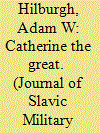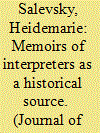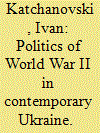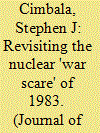| Srl | Item |
| 1 |
ID:
132462


|
|
|
|
|
| Publication |
2014.
|
| Summary/Abstract |
The campaigns of Catherine the Great against the Ottoman Empire in the 1770s reveal key characteristics of operational art. Catherine's campaigns serve as an example of lesser-known conflicts that fulfill the necessary conditions of the numerous schools of thought on operational art. The operational commander, Rumiantsev, developed an operational plan to meet the strategic directives developed by Catherine's permanent 'Council attached to the Court'. His armies used successive tactical actions to engage Turkish maneuver forces and lay siege to its fortresses. The armies were organized into combined arms corps that coordinated to remain mutually supporting with the ability to concentrate at the decisive point when required and the Russian armies to not fight in the linear methods of its Western counterparts. Additionally, the armies and corps conducted distributed operations throughout the theater of war, at times hundreds of kilometers separating them. More importantly, Rumiantsev arranged tactical actions to achieve strategic objectives, the most important part of the definition of operational art. These successive, distributed operations should satisfy the schools of thought that consider Napoleon's campaigns as operational art, but those that understand operational art beginning with Grant and Moltke may see that the Russian Campaigns on the frontiers also move beyond the classical strategy of a single point
|
|
|
|
|
|
|
|
|
|
|
|
|
|
|
|
| 2 |
ID:
132459


|
|
|
|
|
| Publication |
2014.
|
| Summary/Abstract |
There exist incompatible depictions of the Second World War, and specifically of the year 1941. Numerous documents from the archives now available in Moscow and Washington invite comparison with the memoirs of contemporary witnesses. The present article first describes the situation in German-Soviet relations before 22 June 1941. Then it contrasts the memoirs of the interpreters involved (in the German Embassy in Moscow, in the Soviet Embassy in Berlin, and at the delivery of the memorandum by Ribbentrop to Dekanozov) with newly available archive material and with the official records of the Nuremberg trial. The goal of this comparison is to form an assessment of these memoirs as subjective historical sources and to arrive at a new evaluation of their reliability.
|
|
|
|
|
|
|
|
|
|
|
|
|
|
|
|
| 3 |
ID:
132455


|
|
|
|
|
| Publication |
2014.
|
| Summary/Abstract |
This study examines the role of political factors in attitudes toward World War II in contemporary Ukraine. The research question is which factors determine public views of the principal warring sides and their leaders in Ukraine. The analysis of the 2012 Kyiv International Institute of Sociology survey shows that regional values, political party preferences, ethnicity, language, and age have significant effects on views of the Red Army and the Ukrainian Insurgent Army (UPA) during the war and attitudes toward the wartime activities of Joseph Stalin and Roman Shukhevych. Public perceptions of the German Army and Adolf Hitler in Ukraine do not vary much across regions, political parties, and ethnic, language, age, and sex groups.
|
|
|
|
|
|
|
|
|
|
|
|
|
|
|
|
| 4 |
ID:
132457


|
|
|
|
|
| Publication |
2014.
|
| Summary/Abstract |
Between 1979 and 1983, relations between the United States and NATO and the Soviet Union deteriorated gradually due to disagreements and controversies growing out of Cold War rivalry. Some Soviet leaders apparently convinced themselves that there was a nontrivial likelihood of a US or NATO nuclear first use or first strike in the near future, and Soviet intelligence agencies were tasked to anticipate it. A NATO exercise in the autumn of 1983 taking place in this hothouse atmosphere possibly lent itself to misperceptions of American and NATO intentions on account of its realism and some Soviet mind sets. The following discussion revisits the 1983 'war scare' episode by: (1)?reviewing high water marks in the political context leading up to the 1983 'war scare' situation; (2)?considering quantitative evidence on US and Soviet strategic nuclear force structures and possible operational performances; and (3)?deriving from this analysis certain conclusions about the 'war scare' of 1983 and its wider significance.
|
|
|
|
|
|
|
|
|
|
|
|
|
|
|
|